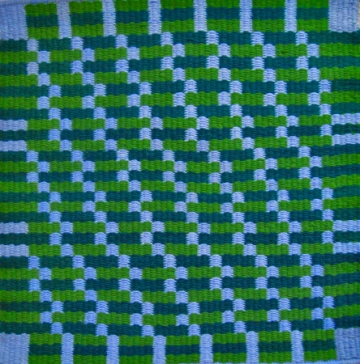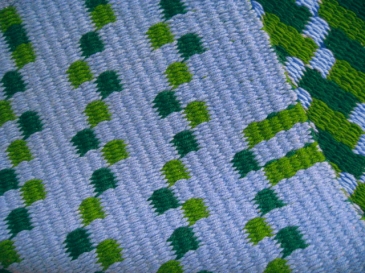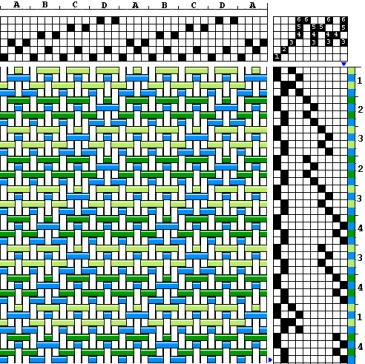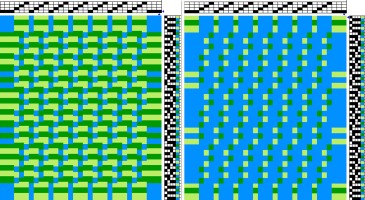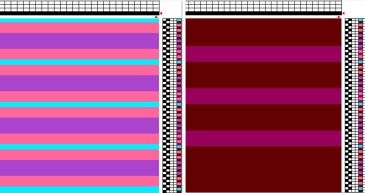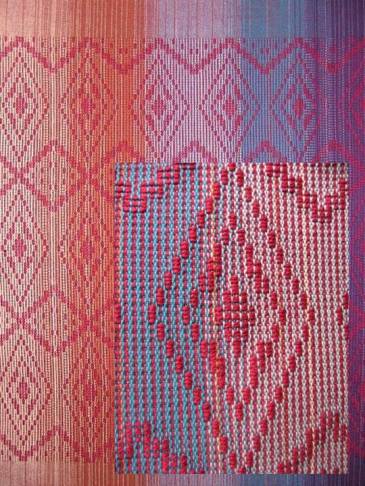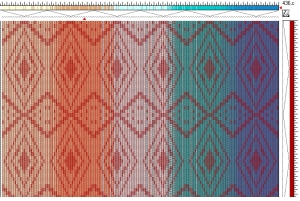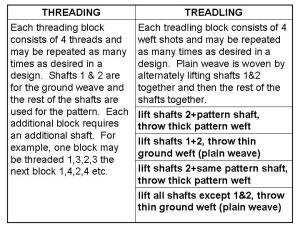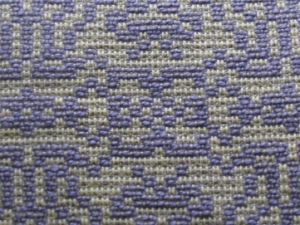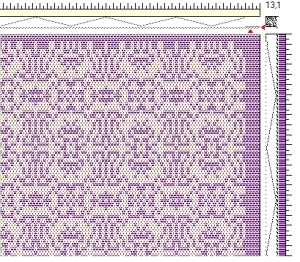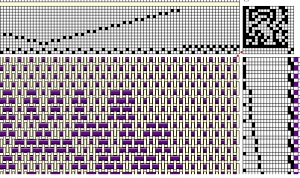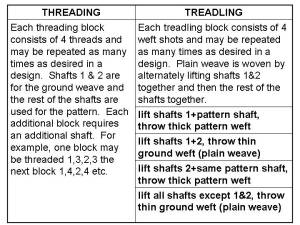…but didn’t know it was called Taqueté.
In the early 90’s I wove several rugs and used Peter Collingwood’s book, The Techniques of Rugweaving, as my guide. I especially liked the two-tie unit, four-end block weaves described in Chapter 8 that use the same threading system that is used in Summer & Winter (S&W). The weave is weft-faced, without any tabby wefts, and when 2 weft colors are used, one weft color shows on one side and the other weft color on the reverse side. Years later, as I was browsing through Weaver’s Magazine #42, the issue about rugs, I read that when S&W is used this way the structure is called Taqueté. Taqueté can also be woven using finer yarns and one might not recognize it as a rug technique.
Since I already did S&W related posts (here and here), I thought it’s time to write about how I wove two of my small Taqueté rugs that are being used as meditation mats. I wove a series of these in different colors and patterns on the same warp by rearranging the treadling blocks for each design.
RUG #1
Profile Draft for Rug #1:
I originally designed these rugs on graph paper starting with a profile draft. In this Rug there are 4 threading blocks – A, B, C, and D, and 4 treadling blocks – 1, 2, 3, and 4. A total of 6 shafts and 8 treadles are needed to weave it on a treadle loom. Here’s what my original profile draft looked like:
Partial Weaving Draft for Rug #1:
The Draft below shows the threading to be 4 ends per block and may be repeated as many times as desired. In this Rug it’s repeated only one time because at a sett of 4 e.p.i. that was enough to create the design that I wanted. If read left to right, the threading goes like this: Block A (1,3,2,3); Block B (1,4,2,4); Block C (1,5,2,5); and Block D (1,6,2,6)
The Draft below also shows the treadling to be 4 wefts per block that may be repeated as many times as desired. For lack of space, this Draft does not show the actual number of times each block is repeated to create the design for this Rug which is 5 times (total of 20 wefts). Note that 2 treadles are pressed at the same time for each weft because otherwise 16 treadles would be needed instead of only 8. If read from top to bottom, the treadling goes like this: Block 1: lift shafts 1+3 together and throw a weft with the color indicated; lift shafts 1+(4,5&6) together and throw the second weft with the color indicated; lift shafts 2+3 and throw the third weft with the color indicated; and lift shafts 2+(4,5&6) together and throw the fourth weft with the color indicated. Likewise, refer to the Draft for treadling Blocks 2, 3, and 4.
The Profile draft is a shorthand notation for a thread-by-thread draft (the Partial Weaving Draft here). Once you know what each block represents you simply follow the block order in the Profile draft when threading and treadling.
Weft-Faced View Profile Draft for Rug #1:
By entering information a particular way into my weaving program, namely in liftplan mode with alternating colors and in weft-faced view, an amazing profile draft is generated that can easily be changed and used with the block substitution feature to create other weave structures, not only Taqueté.
RUG #2
Partial Weaving Draft and Weft-Faced View Profile Draft for Rug #2:
Although I wove this Rug on the same warp as Rug #1, it can easily be woven using only 3 shafts and 4 treadles because it’s really just the repetition of 1 threading block and 1 treadling block. Again, for lack of space, the Partial Weaving Draft does not show the actual number of treadling repeats but together with the Weft-Faced View Profile Draft you get the idea:
Additional Notes:
For both these rugs I used 5/2 warp twist cotton tripled with a sett of 4 e.p.i. (ends per inch) for the warp, and a 4-ply light/medium rug wool tripled for the weft approximately 20 p.p.i. (picks or wefts per inch). The finished rugs are 30″ x 32″ and each weighs about 3 lbs., nice and thick and comfortable to sit on. I have also used linen for the warp when weaving larger rugs, but I heard that seine twine is also very good, even better because fringes don’t fray as much with less overall wear and tear over time.
My favorite large Taqueté rug that I wove in 1990 is in our living room and we really do use one side in the summer and turn it over to the reverse side in the winter because both sides are equally nice. It’s the second image on my Gallery – 1985 & 1990 page.
By the way, I posted an image of a new shadow weave sample I wove this year for the Fine Threads Study group at Complex Weavers, it’s on my Gallery 2010 page, the fourth image down.
